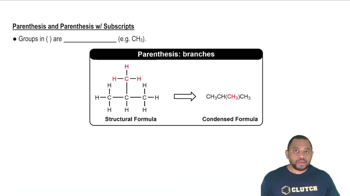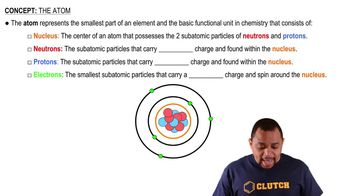Here are the essential concepts you must grasp in order to answer the question correctly.
Chemical Formula Interpretation
A chemical formula represents the types and numbers of atoms in a compound. Subscripts indicate the number of atoms of each element present in the molecule. For example, in Mg3(PO4)2, the '3' indicates three magnesium atoms, while '(PO4)2' indicates two phosphate groups, each containing one phosphorus and four oxygen atoms.
Recommended video:
Intepreting the Band of Stability
Parentheses in Chemical Formulas
Parentheses in chemical formulas are used to group atoms that are part of a polyatomic ion or a molecular unit. The subscript outside the parentheses applies to all atoms within the parentheses. For instance, in Ca(OH)2, the '2' means there are two hydroxide ions (OH) for each calcium atom, resulting in two oxygen and two hydrogen atoms.
Recommended video:
Parenthesis and Parenthesis w/ Subscripts
Counting Atoms in Compounds
To determine the total number of each type of atom in a compound, one must carefully account for both the subscripts and any coefficients. This involves multiplying the subscripts by any coefficients and summing the contributions from all parts of the formula. For example, in BaCl2, there is one barium atom and two chlorine atoms, leading to a total count of three atoms.
Recommended video:
 Verified step by step guidance
Verified step by step guidance


